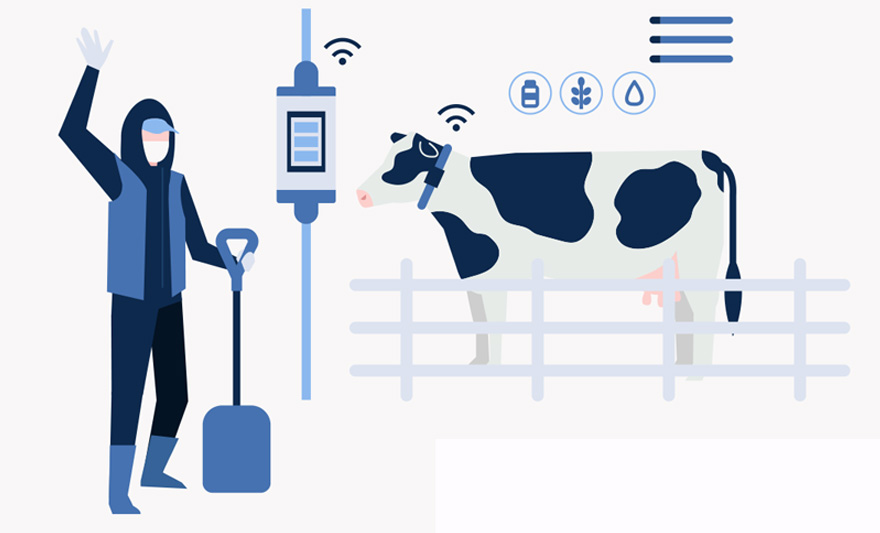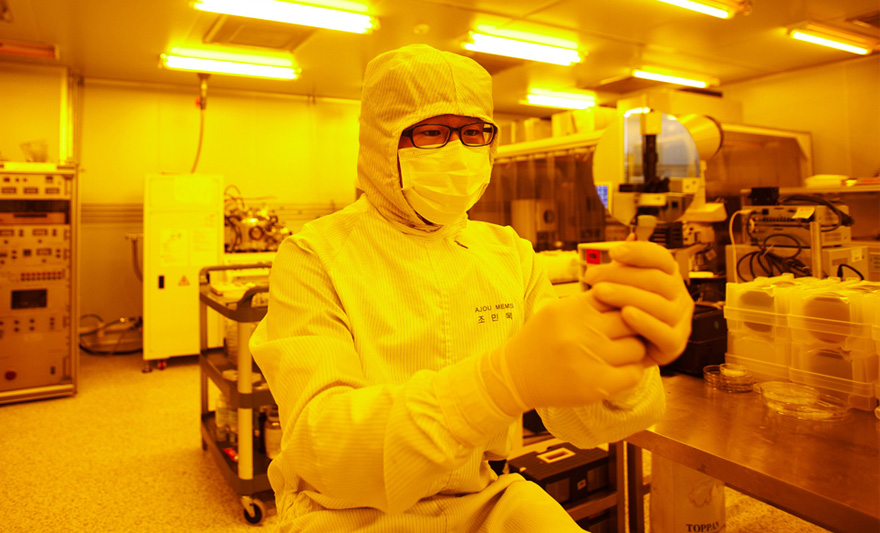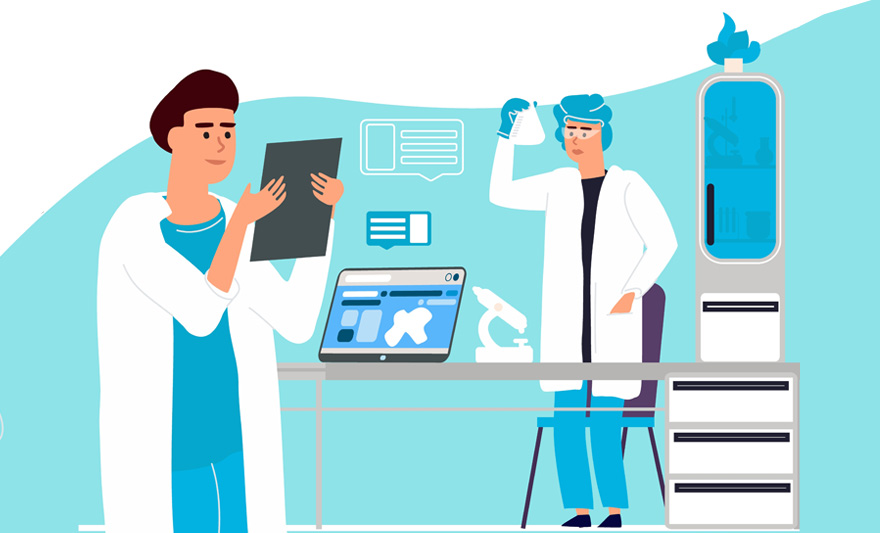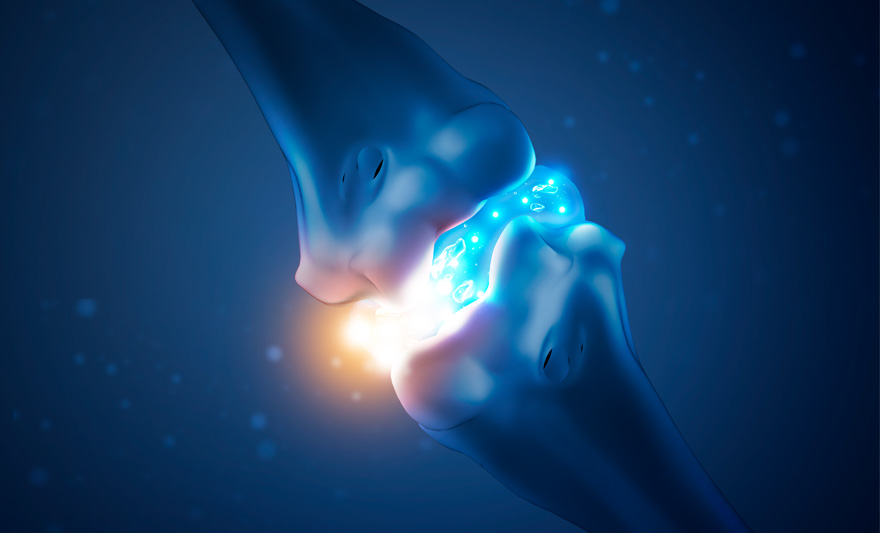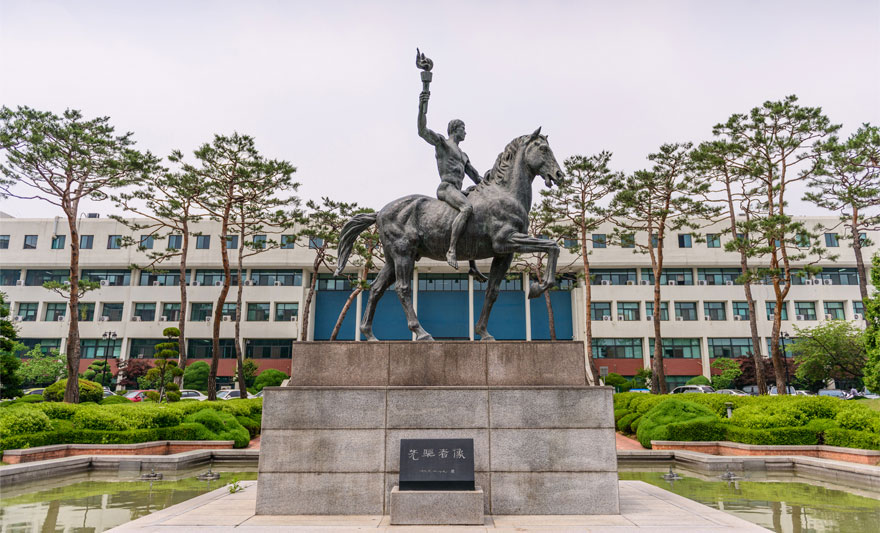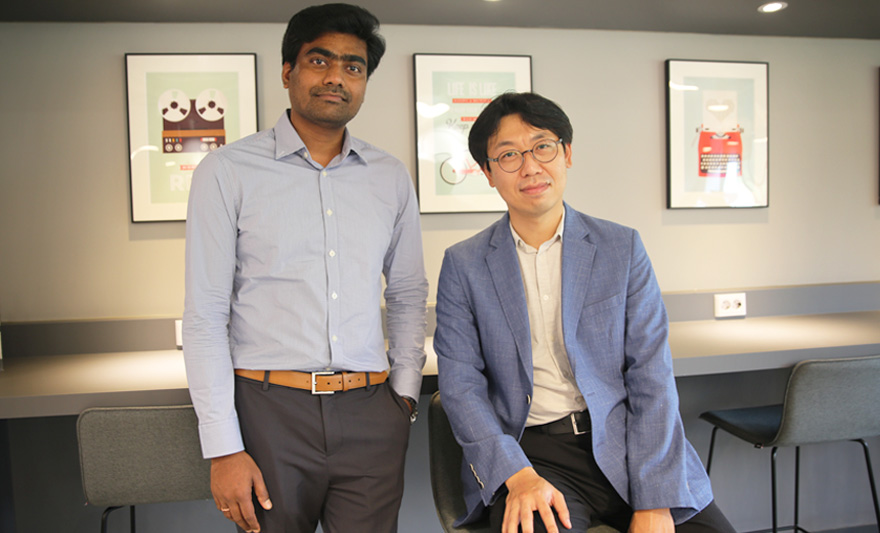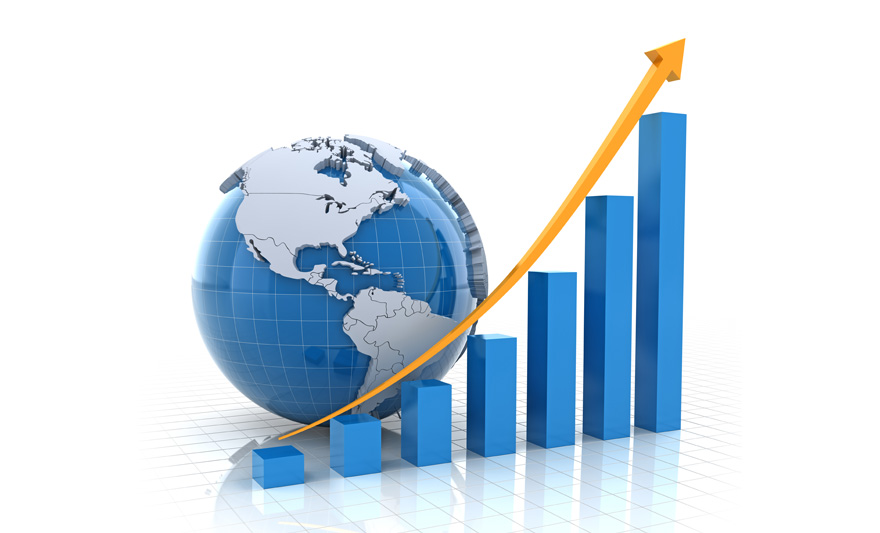-
A joint research team from Ajou University has developed a catalyst response technology that can produce hydrogen and carbon using methane, the main component of city gas, or natural gas. This is a cutting-edge energy technology that can concurrently mass produce green, affordable hydrogen fuel and high purity, high value-added carbon.The joint research team, led by Prof. Seo Hyung-tak (Dept. of Materials Science and Engineering, Graduate School Department of Energy Systems Research) and Prof. Kim Yu-kwon (Chemistry, Graduate School Department of Energy Systems Research) announced the development of technology to produce hydrogen gas and solid carbon directly converted from methane using a bubble column reactor injected with molten liquid alloy catalysts and zirconia. Their achievement was published in the online edition of Chemical Engineering Journal (IF=13.273) on July 7, 2021 under the title, “Enhanced Efficiency in CO2-free Hydrogen Production from Methane in a Molten Liquid Alloy Bubble Column Reactor with Zirconia Beads.” Lee Young-jae, a doctoral student at Ajou University, and Dr. Noh Yong-gyu took part as first co-authors, and another doctoral student, Kim Jin-a, and Prof. Shankara Kalanur also joined.Hydrogen, a clean fuel that emits water after use, has recently gained recognition as a next-generation energy source and is increasingly applied to diverse industrial fields. Mass production of hydrogen as fuel is commonly achieved by reforming fossil fuels, but the process emits CO2 that is nine times greater than the weight of hydrogen thereby produced.Due to this and other reasons, research has recently been active in photoelectrochemical water splitting technology using electricity or solar energy towards reducing emission of CO2, a major greenhouse gas. However, barriers have existed to these efforts as the unit cost of production has been at least five to six times the cost of reforming fossil fuels, and it could not be mass produced. Therefore, development of a way to mass produce hydrogen in an affordable and CO2-free manner is urgently needed if we are to realize a hydrogen economy, with hydrogen energy as a completely clean fuel.The Ajou University research team focused on methane gas (CH4), a major component in city and natural gas. When methane gas undergoes a pyrolysis process using solid catalysts at temperatures greater than 1000℃, it produces hydrogen gas and solid carbon. The solid carbon thereby produced could not be commercialized previously as it becomes deactivated. When solid carbon accumulates on the surface of the catalyst, it ultimately prevents the chemical reaction of methane gas there, as a result of which its reaction activity rapidly disappears.To address this limitation, researchers have recently turned their attention to the use of low-melting liquid metal (LM) alloy catalysts (liquid metal catalyst combining low-melting metals, such as tin, and high-melting metals, such as nickel, which are high catalyst activation). In other words, direct molten catalyst methane conversion technology injects methane gas into molten liquid metal alloy to produce hydrogen. At the same time, flotation and reaction are maintained due to the difference in carbon layer density on the surface of the liquid catalyst while also producing solid carbon.The joint research team developed a new method, based on this direct molten catalyst methane conversion technology, to discover that maximizing the surface area of the boundary between methane gas and liquid catalyst by reducing the residence time of methane gas inside the liquid catalyst and size of the methane gas bubble in the methane decomposition reaction using liquid catalysts is a critical factor in enhancing reaction efficiency. The research team developed a new reactor structure by additionally injecting zirconia (a mixture of zirconium and oxygen (ZrO2) which has a high melting point, is not easily decomposed, and is in a white crystalline form at room temperature) to the liquid catalyst in the reactor to minimize the size of the methane bubble and complicate the gas flow channel, which increased gas residence time.The adoption of a new reactor structure resulted in a high hydrogen conversion rate (about 37% methane at 985℃, lower than the existing temperature of at least 1000℃), and strong reaction durability as catalyst activity increased even after a long production period of more than 150 hours. In general, methane thermal decomposition reaction at 1000℃ or lower lowers the cost of thermal energy in accordance with reactor quality, but it also resulted in a rapid decrease in conversion rate. The Ajou research team overcame this stumbling block to record the highest conversion rate and continuous reaction at low temperature. The carbon produced using this new method was in a form that is high purity and high value-added (carbon nanotube and fiber filament). Such carbon can be used in batteries and fuel cells. This new development taps into the potential not only for environmentally-friendly mass production of hydrogen but also high-applicability carbon materials.“The existing hydrogen production methods using fossil fuels will inevitably undergo a rise in price due to trends toward stronger regulations on CO2 emissions,” said Prof. Seo. “This research is significant in that it has opened up a new green and affordable path of mass production of hydrogen.”He also added, “It can be remarkably economical if the carbon produced simultaneously and continuously with hydrogen is of high purity and has high value-added properties. We will continue our research and aim for its commercialization.” The research was sponsored by the Industrial Technology Alchemist Project managed by the Korean Ministry of Trade, Industry, and Energy (MOTIE), Korea Evaluation Institute of Industrial Technology (KEIT) and C1 Gas Refinery R&D Center managed by the Korean Ministry of Science and ICT and the National Research Foundation of Korea (NRF).This is a concept diagram of the production of hydrogen and carbon using direct methane decomposition based on molten liquid alloy catalysts: when methane is injected into the reactor, which is mixed with liquid metal alloy catalyst and zirconia, and heated, high purity hydrogen forms inside the liquid catalyst, while at the same time creating carbon fiber. Carbon fiber is of low density and will float to the surface. This is why it is not affected by the catalytic reaction and long hours of continuous production of hydrogen and carbon are possible.*PhotoFrom far left: Prof. Seo Hyung-tak, PhD students Lee Young-jae and Park Jin-a, and Prof. Kim Yu-kwon
-
521
- 작성자OIA
- 작성일2021-09-06
- 4478
- 동영상동영상
-
An Ajou University research team under Professor Kim Jong-hyun has been selected by the Ministry of Science and ICT (MSIT) to participate in the Korea-Australia Strategic International Joint Research Project. Professor Kim Jong-hyun (Department of Applied Chemistry and Biological Engineering/ Graduate School of Molecular Science and Technology) announced that his team will participate in the Korea-Australia Strategic International Joint Research Project together with Professor Jan Seidel’s team from the University of New South Wales’ (UNSW) Department of Materials Science and Engineering with the aim of developing an IoT-integrated independent sensor module for AI-powered diagnosis of livestock disease. The project period is two years (2021-2023) and will have an expected KRW 1 billion in project expenses.The MSIT has been leading the Strategic International Joint Research Project with an aim to address technological gaps and secure advanced technology through strategic international cooperation, with a view towards the impact of the Fourth Industrial Revolution and the technological abilities of research counterparts with the common goals of addressing climate change, micro dust, infectious disease, and other global challenges. The joint research team plans to develop an independently-run IoT sensor module that monitors the health of livestock in real time to diagnose and forecast pathogenesis, and create data mining analysis-friendly solutions for livestock diseases.A sensor module, which is the development goal of this project, will be designed around an independent power system which does not require replacing batteries and enables detection of various conditions of livestock health at the same time. Accordingly, it is expected to significantly reduce livestock management costs for Australian cattle ranchers as the country has a very large number of grazing livestock. The two countries’ research teams plan to lead studies focusing on their specialized fields. Professor Kim Jong-hyun’s team will develop an IoT-integrated independently-operated sensor module, while the Australian team will optimize a sensor module for localization and analysis of livestock health data. Narromine, a town in Australia, will provide the town’s livestock data as a test bed for the project so that the sensor module, the outcome of the project, can be adopted by the local agro-livestock industry. Professor Kim, who is heading the project, stated “Our team has secured advanced technology through continuous research collaboration with the Australian team,” and added, “Based on such collaboration, the bilateral project will enable us to successfully develop an IoT sensor module for diagnosis of livestock disease.” In addition, Kim said, “Australia is home to the world’s largest livestock headcount in a variety of species combinations, and is therefore very interested in the project. […] Our team has completed the first verification test of a neckband-type sensor module that we developed early on, and is currently discussing management authority of the final product with an Australian company.”Aside from joint technological development, which is the primary goal of the joint research project, Kim’s team plans to strengthen international cooperation and professional training by promoting active exchange of students and researchers between Ajou University and UNSW.In addition to Ajou University and UNSW, other involved institutions include the Korea Institute of Materials Science, the Korea Electronics Technology Institute, Pusan National University, Charles Stuart University of Australia, and the town of Narromine.인공지능 기반 가축질병 진단 IoT 통합형 독립구동 센서모듈 개발Developing an IoT-Integrated Independently-Operated Sensor Module for AI-Powered Diagnosis of Livestock Disease기존기술Existing Technology교체형 배터리 기반의 센서Sensors based on battery swap system사람에 의한 가축질병 진단Diagnosis of livestock disease done by humans자율전원 및 진단Autonomous power system and diagnosis제안기술(차별성)Proposed Technology (Differentiation)배터리 자율전원 IoT 디바이스 센서 모듈Autonomous battery-powered IoT device sensor module실내외 현장 적용가능Application possible inside or out자율전원 모듈Autonomous power module가축진단 데이터 구축Construction of livestock diagnosis data멀티 빅데이터 구축 가능Possible to construct multi-sourcebig data 전용, 진단Dedicated, diagnostic
-
519
- 작성자OIA
- 작성일2021-08-03
- 7941
- 동영상동영상
-
아주대 최근 기술이전 수익Ajou University’s Latest Technology Trasfer Revenue전국 7위7th in Korea11.8억원/19.6억원/21.4억원/26.3억원/33.5억원KRW 1.18 billion/KRW 1.96 billion/KRW 2.14 billion/KRW 2.63 billion/KRW 3.35 billionAjou University has led 5 consecutive years of growth in technology transfer revenues through continuous posting of outstanding performance in technology commercialization. Technology transfer revenue refer to money paid by companies to the university in exchange for intellectual property with an aim to use the research findings of university research teams, which signifies the university’s strength in research.In June of every year, the Ministry of Education publicly announces each university’s technology transfer revenues and contract performance through its annual University Information Disclosure, wherein Ajou University recorded a total of KRW 3.35 billion in 2020 university technology transfer revenues, ranking Ajou 7th in Korea. The average technology transfer revenueearned by domestic universities in 2020 is around KRW 710 million. Ajou is the only university with continuously growing profits from technology licensing in the latest five-year period. It recorded KRW 1.18 billion in 2016, followed by KRW1.96 billion in 2017, KRW 2.14 billion in 2018, KRW 2.63 billion in 2019, and KRW 3.35 billion in 2020.The scale and scope of technology transfers at each university represent the publication of papers by and academic performance of faculty members, which shows that a university’s research is actually benefiting society and companies, and indicates that material industry-academia cooperation is taking place. Various departments, including the departments of Engineering, Natural Sciences, School of Medicine, Colleges of Pharmacy, and Nursing, are all located on one campus which facilitates inter-disciplinary cooperation. As the university established a dedicated Technology Licensing Office and employs field-specific professionals, it has been able to operate a systematic and advanced support platform for technology commercialization through its Support Program Tailored to Intellectual Property Life Cycle. Towards providing more customized assistance, Ajou’s Technology Commercialization Team has established a full cycle support system for appointed professors—early, mid-term and later period. The Team also runs an outreach program on campus to raise awareness of technology commercialization. With an aim to promote more active utilization of its research outcomes, Ajou University is also actively involved in a variety of external programs including ▲the BRIDGE+ Program (under the Ministry of Education and the National Research Foundation), ▲the Intellectual Property Reinvestment Support Program (under the Korean Intellectual Property Office and Korea Patent Strategy Development Institute), and ▲the Technology Management Center (TMC) Program of Universities (under the Ministry of Science and ICT and the Commercialization Promotion Agency for R&D Outcomes). This year, a total of 413 tertiary institutions were included in the Ministry of Education’s University Information Disclosure (223 universities, 145 junior colleges, 45 graduate universities). Records were disclosed in 14 areas, 67 items, and 107 sub-category items, including school, students, finances, etc. In the technology transfer revenue category, KAIST ranked 1st followed by ▲Seoul National University ▲Kyunghee University ▲Yonsei University and ▲Korea University.
-
517
- 작성자OIA
- 작성일2021-08-03
- 7469
- 동영상동영상
-
-
515
- 작성자OIA
- 작성일2021-08-03
- 7508
- 동영상동영상
-
Professors Kim Wook and Yang Si-young’s team confirmed the osteoarthritis treatment mechanism of globular-shaped self-assembled hyaluronic acid nanoparticles. The recent finding is expected to contribute to improving in vivo safety and efficacy of linear hyaluronic acids used in chondroprotective agents for osteoarthritis. Professor Kim Wook (Department of Applied Chemistry & Biological Engineering, left in photo) and professor Yang Si-young (School of Medicine, right in photo) of Ajou University announced that the team has confirmed the chondroprotective efficacy of globular-shaped self-assembled hyaluronic acid nanoparticles and inflammation relief action. This means that target-specific drug carriers can become a potential therapeutic agent for osteoarthritis treatment.The study has been published in Biomaterials (IF 10.317), an international journal exploring the science of biomaterials and their translation towards clinical use, on June 19th with the title, “Self-Assembled Hyaluronic Acid Nanoparticles for Osteoarthritis Treatment.”The number of osteoarthritis patients continues to rise globally as lifespans have continued to lengthen, bringing to population aging. However, injection-type high-molecular-weight hyaluronic acids currently used in drugs and chondroprotective agents are not stable within a living body. The research team focused on self-assembled hyaluronic acid nanoparticles which are mainly used as in-vivo friendly, non-toxic, target-specific and long-acting drug carriers. As compressed globular-shaped self-assembled hyaluronic acid nanoparticles are relatively safer in vivo than linear hyaluronic acids, the team assumed that they are long-standing and provide increased inflammation relief. Accordingly, the team injected self-assembled hyaluronic acid nanoparticles into the knee joint of mouse models and observed through a multiphoton confocal microscope that the nanoparticles that penetrated the cartilage cell membrane conjugated with CD44 receptors and protected joint cartilage against osteoarthritis progression.This is evidence that multiple CD44-binding sites of nanoparticles conjugate with multiple CD44s at the same time, creating CD44 clustering in the cell membrane which effectively inhibits CD44 expression. The research team further explained that the drug carrier—self-assembled hyaluronic acid nanoparticles—itself, without any drug load inside, can inhibit CD44 receptors which aggravate joint cartilage erosion.In addition, the team reaffirmed that CD44 receptors can be a target for developing osteoarthritis treatments. CD44-deficient mouse models showed significantly lower osteoarthritis development compared to the control group with CD44 expression even when artificially inducing osteoarthritis in knee joints. The latest study suggests potential use of self-assembled hyaluronic acid nanoparticles as osteoarthritis treatments that interact with CD44. This recent finding is very meaningful as it provides a clue to overcoming the limitations of current linear hyaluronic acids and their low stability and inflammation-inducing effects due to product degradations.The study was sponsored by the Ministry of Science and ICT and the National Research Foundation of Korea as part of their Middle-grade Research Program and Bio/Medical Technology Development Program.<Self-Assembled Hyaluronic Acid Nanoparticles for Osteoarthritis Treatment Mechanism>
-
513
- 작성자OIA
- 작성일2021-08-03
- 7823
- 동영상동영상
-
Ajou University and the Emirates Nuclear Energy Corporation (ENEC) in the UAE cohosted an industrial mathematics seminar on June 23rd. UAE’s Ministry of Education and Khalifa University also participated, presenting on industrial mathematics use cases in various fields of research. In the online seminar, professor Kwon Soon-sun (Ajou University’s Department of Mathematics) gave a presentation entitled, “Applications of Mathematics and Statistics in Clinical Medicine and Industry.”Choi Soo-young, dean of the Department of Mathematics, explained Ajou University’s strength in industrial mathematics and its current status during the panel discussion and engaged in an in-depth discussion with participants from a variety of other institutions.Ajou University President Park Hyung-ju, in his opening remarks, stated that Ajou University expects to build cooperative relations with UAE research institutions through the opportunity of the webinar, promote active exchanges between researchers and stimulate international activities.The ENEC and Ajou University began discussing bilateral research cooperation in the field of industrial mathematics in April this year. On June 11th, Vice President of ENEC, Mohamed Chookah, and his team visited Ajou University and held detailed discussions on ways to further advance research cooperation in the field of energy development centered around Ajou’s strength in industrial mathematics.
-
511
- 작성자OIA
- 작성일2021-08-03
- 7578
- 동영상동영상
-
Ajou University has been selected as one of Korea’s top 5 in THE Young University Rankings, along with KAIST, POSTECH, UNIST and GIST.The UK’s Times Higher Education (THE) lists the world’s best universities that are no more than 50 years old. In this year’s THE Young University Rankings, Ajou University ranked 152nd internationally and 5th domestically. Ajou University has moved up more than 50 ranks from last year (201st~250th). This year’s improvement is very meaningful as it came amid a growing number of universities participating in THE Young University Rankings. Improving its overall evaluation scores ranging from education conditions, research, paper citations, globalization and industry-academia cooperation has been instrumental in driving this improvement. The UK university evaluation institution THE announced its 2021 THE Young University Rankings on June 23rd with results of its evaluation of 475 international universities under 50 years of age. THE has been publishing the rankings since 2010 using indicators such as ▲education conditions (30%) ▲research results (30%) ▲paper citations (30%) ▲globalization (7.5%) and ▲industry-academia cooperation (2.5%). Nanyang Technological University (NTU) tops the global ranking of the best young universities followed by France’s PSL (2nd) and the Hong Kong University of Science and Technology(3rd). Global rankings of Korea universities include KAIST in 4th place and POSTECH and UNIST in 8th and 10th place respectively. Ajou University has made a variety of efforts to attract talented faculty and strengthen its research capabilities. The university has established a new “Best Paper Awards” which awards its professors according to qualitative evaluations of their papers and expanded its settlement research expenses for newly-hired professors. For instance, newly-hired professors at Ajou University in science and engineering are entitled to receive a maximum of KRW 100 million in research grants, while those in the humanities and social sciences are entitled to a maximum of KRW 50 million. The period of eligibility for this research grant, spanning receipt of the grant to the submission of results, has been extended from three years to four. To improve its research capability, Ajou has subsidized research expenses of post-doctorate researchers and actively invited outstanding research experts through its participation in international symposiums. Efforts like this have resulted in the university earning KRW 3.35 billion in technology transfer revenues last year. These proceeds come from industry-academia cooperation projects and are an indicator that signifies research strength. Ajou University’s proceeds have been on the rise for the past five consecutive years. Technology transfer revenue proceeds refer to money paid by companies to the university in exchange for acquiring intellectual property towards using the outcomes of research by university research teams. Ajou University has been seeing continuous good results in many university rankings announced by global university rating institutions. It ranked in the 531st-540th group by the QS World University Rankings, representing 3 consecutive years of improvement, published in early June this year and 130th in THE Asia University Rankings 2021—representing a move up 49 places from last year. In addition, Ajou ranked in the 201st-300th group in THE Impact Rankings 2021, moving over 100 places up year-on-year. THE Impact Rankings look into social responsibility activities at each university, centered around the UN Sustainable Development Goals (SDGs).
-
509
- 작성자OIA
- 작성일2021-08-03
- 9236
- 동영상동영상
-
Professor Lee Jung-ho’s Team from Ajou University’s Department of Mechanical Engineering has been selected as a lead research team for the 1st Energy Technology Development Project launched in 2021 by the Ministry of Trade, Industry and Energy (MOTIE). The MOTIE is leading around 80 projects in the fields of new and renewable energy, energy-related new industry, clean thermal and nuclear power plant, smart grid, and public R&D in order to realize a carbon neutral society and promote technology development for Green New Deal projects that will enable the country to respond to changes in energy environment. A total of KRW 195 billion will be shared amongst 119 projects. Professor Lee Jung-ho (left in photo) has been selected to lead a project on core technology and module development to improve the performance of heat pipe heat exchangers using a boiling model, which Lee’s team applied for within the category of “Projects related to technology development for energy demand management.” The project timeline is from May 2021 to December 2025 and is projected to cost KRW 13.5 billion.A heat exchanger transfers heat from a region of higher temperature to one of lower temperature through a heat pipe—a very high thermal conductance device which does not consume any external energy. The device structure is simple and is not easily deformed by heat, lending it to use as a heat exchanger for recovery of waste heat and cooling/heat exchange systems in the aerospace industry.Professor Lee Jung-ho’s team (right in photo) plans to develop a boiling pipe heat exchanger. A boiling pipe uses ‘boiling’ heat transfer technology which surpasses the performance of existing heat exchangers, dependent as they are on evaporation. The new heat transfer technology is gaining a lot of traction as a core technology for advanced management of heat from high heat sources such as cooling devices for power semiconductors, electric vehicles, energy storage systems (ESSs) and laser-guided munitions.The team aims to contribute to reducing greenhouse gas emissions and lower energy costs of power plants, boilers, incinerators, etc. It expects to add value by cutting the indirect energy waste in waste heat recovery by small and medium-sized companies.Lee Jung-ho, who heads the project, was appointed in March 2021 as professor in the Department of Mechanical Engineering. He is one of the top Korean experts in advanced insulation and heat management technology, and has developed heat system insulation technology and heat management technology over the past 25 years.Leading institutions participating in this project led by Ajou University include Korea Institute of Machinery and Materials, Chungang University Industry Academic Cooperation Foundation, Ulsan National Institute of Science and Technology (UNIST), Korea Advanced Institute for Science and Technology (KAIST), and Uniwel Corporation.<Overview of a Boiling Pipe Heat Exchanger>히트파이프(증발/막응축)Heat Pipe (Evaporation/Filmwise Condensation)비등파이프(비등/적응축): 상변화 열전달 촉진Boiling Pipe (Boiling/Dropwise Condensation): Enhancing phase change heat transfer히트파이프: 파이프 내부 증발과 막응축을 이용한 열교환Heat Pipe: Heat exchange through evaporation and filmwise condensation inside pipe비등파이트: 파이프 내부 비등과 적응축을 이용한 열교환Boiling Pipe: Heat exchange through boiling and dropwise condensation inside pipe열교환기 효율 양상에 따른 Compact 구현Creating a compact module by enhancing heat exchanger efficiency
-
507
- 작성자OIA
- 작성일2021-08-03
- 7076
- 동영상동영상
-
Ajou University is set to embark on an extended reality (XR) project after successfully winning the “2021 XR Lab Project” co-hosted by the Ministry of Science and ICT (MSIT) and the Korea Radio Promotion Association (RAPA).The project aims to advance the field of XR, which includes virtual reality, augmented reality and mixed reality, and develop professionals by supporting their research, start-up activities and technology commercialization of XR content and services. The selected research teams will be granted KRW 1.18 billion over the next 3 years toconduct their project.As part of the project, the Ajou University team, led by chief researcher and professor Seok Hye-jung (Department of Digital Media) and consisting of professors Teemu H. Laine, Oh Kyu-hwan, Chang Woo-jin and Kim Eun-ha (Department of Psychology), professor Kim Tae-sun (Department of Education, counselling major), and professor Jung Tae-sun (Department of Software), will establish a VHEX lab (Virtual Human Experience Lab) together with doctoral, master’s and undergraduate students.The research team will develop VR content and a platform that enable diagnosis of empathetic patterns in adolescents and provide training. The team aims to create lively, well-organized content that harmoniously converges virtual reality and physical reality using VR, AR and other ICT technologies, thereby attracting young people to participate more actively in diagnosis and training. The ultimate goal of the empathetic pattern diagnosis and training is to reduce social issues including bullying and ostracizing others at schools and help teenagers have a more balanced perspective and empathetic abilities.The Ajou research team intends to commercialize the VR platform and will also execute training programs for psychology professionals working in Fourth Industrial Revolution (4IR) fields.The Life Media interdisciplinary program of Ajou Graduate School has been leading various joint research projects to develop Well-Life content centering around positive psychology and ICT technology.The MSIT and RAPA have selected 6 new XR labs, including the Ajou lab, this year. The selected labs will receive a variety of support including research grants, consulting services for commercialization, expert seminars, opportunities to participate in exhibitions, and promotion of research outcomes.<Overview of XR Content Platform for Empathetic Patterns Diagnosis and Training for Each Type>공감유형진단VREmpathetic Patterns Diagnostic VR[인지-감정, 긍정-부정, 소수-다수] + 공감 표현 수준 측정[Awareness-Emotion, Positive-Negative, Minority-Majority] + Measure level of empathetic expressions인공지능 가상 캐릭터와 상황 시나리오Virtual AI character and event scenario상호작용 응답 생체 센서Interactive/responsive biosensors공감 유형 진단 결과Empathetic patterns diagnosis result공감교육VREmpathy Training VR편향된 공감의 밸런스를 맞추기 위한 공감 교육 액티비티Empathy training activities to rebalance one’s biased empathy 공감 유형별 공감 교육 추천Empathy training recommendation by each empathy type롤플레잉 게이미피케이션Role-playing gamification상호작용 액티비티Interactive activities
-
505
- 작성자OIA
- 작성일2021-08-03
- 6397
- 동영상동영상
-
Photo Essay & Video Contest: Life at Ajou 2021 was held with the participation of foreign students enrolled at Ajou University. Participants submitted photos and videos featuring their favorite places, classes, friends, etc. at Ajou. Hosted by the International Exchange and Cooperation Team on May 15, the awards ceremony was split into two sessions: the awards ceremony itself and presentations on the prize-winning photos and videos. Undergraduate, graduate, and exchange students from France, Germany, Bangladesh, and other nations took part in the contest, showing their interest in and affection towards Ajou. In the photo category, Leonardo from Germany ranked first. He featured cherry blossoms on the campus of Ajou and Gaon Garden, where students frequently meet up.Meanwhile, Babatobi from Nigeria and Leonardo from Germany won first place in the video category. The duo’s video covered the friendships built with Ajou students from around the world. The award-winning photos and videos will be used for international promotions by the Ajou University Office of International Affairs. Ajou University has sisterhood relationships with 320 universities and institutions in 67 countries around the world. A variety of programs are now underway with these universities, including student and faculty exchanges, dual degrees, and joint studies. Some 1,100 foreign students from undergraduate, graduate, and exchange programs are currently enrolled at Ajou. Despite the COVID-19 crisis, around 140 exchange students have been studying at Ajou during the first semester of 2021.
-
503
- 작성자OIA
- 작성일2021-07-01
- 7316
- 동영상동영상
-
A team of researchers led by Prof. Kim Sung-hwan, from the Departments of Physics and Energy Systems Research, has developed electronic skin capable of generating energy with a touch using silk protein nanofibers. This development is expected to be used as a next-generation bio-electronic material, generating electric energy or acting as sensory organs upon attachment to the human skin or soft robots. Prof. Kim announced successful development of electronic tattoos, which make it possible to draw circuits on silk protein nanofibers with carbon nanofiber ink using electrostatic-harvesting materials. Protein derived from silkworms is a skin-friendly, high-molecular biomaterial. The achievement was published online under the title, “Self-powered and Imperceptible Electronic Tattoos based on Silk Protein Nanofiber and Carbon Nanotubes for Human-machine Interfaces,” in Advanced Energy Materials (Impact Factor 25.245), a prestigious international journal covering energy materials, on May 11. Prof. Narendar Gogurla, Research Assistant Professor, participated as first author and worked together with Prof. Kim. There is a fast-growing body of research worldwide on materials for next-generation electronic healthcare devices for human-machine interfacing. Electrostatic-harvesting materials that leverage electrostaticity as an energy source are gaining more traction than ever. Electrostatic-harvesting materials can be used as a source of energy to move healthcare materials and artificial sensing organs that relay information related to human body movements. However, in order to increase energy efficiency, compatible materials should be used (e.g. hair and plastic show ideal electrostaticity), serving as an obstacle to generating electric energy in direct contact with human skin. In addition, the fact that the materials should be attached to human skin, no matter how uneven, while being composed of elements harmless to the human body, makes it harder to accelerate outcomes for research on electrostatic-harvesting materials. The team focused on silk proteins available from natural sources. Protein derived from silkworms is a skin-friendly, high-molecular biomaterial with superior physical and chemical properties. In the first step, the researchers make silk nanofiber paper, of a thickness equivalent to one-fiftieth of a strand of human hair, using electrospinning. Afterwards, they draw circuits on the silk nanofiber paper using carbon nanofiber ink and brush. Once the ink dries, the drawn circuits come out. Placing the circuits on slightly moist skin creates the electronic tattoo.The electronic tattoo is ultrathin, so it can be put on finely-wrinkled skin surfaces like finger pads while maintaining stability of its electric properties during everyday activities, besides taking showers. Electronic tattoos can easily be wiped off with wet wipes. Materials derived from silk nanofibers are harmless as the silk nanofibers are injected in the middle of the electronic tattoos.Interestingly, electronic tattoos attached to the human skin have the highest efficiency, signifying that other materials, including disposable gloves, should be worn to increase the efficiency of electrostatic energy. The harvested electric energy is sufficient to operate small electronic devices, such as LEDs and stopwatches. The fact that electric signals are generated with a single touch means that the tattoos can be used as artificial sensing organs. The team successfully drew pixel tattoos on the skin, proving that drawn circuits are capable of being converted into electric signals with the touch of a finger. Prof. Kim explained: “Although there has been significant progress in research on harvesting energy from the human body, the problems related to human-machine interfacing have been relatively neglected. Using proteins, of which natural skin is composed, interfaces capable of bridging the material difference between the human body and electronic devices can be developed.”He also added: “Our project is significant in that our invention can help increase the application of biomaterials to a variety of electronic devices. We hope to see our product applied to a wide range of healthcare products and soft robotics in the future.”The research was sponsored by the Rural Development Administration, the National Research Foundation of Korea, the BK21 FOUR, and the Gyeonggi-do Regional Research Center.Description: (Left) A conceptual diagram of a silk, electrostatic electronic tattoo, able to collect electric energy with a single touch on the skin using biocompatible electronic tattoos. (Right) An experiment on artificial sensing organs. Circuits drawn as pixel tattoos on the skin are capable of being converted into electric signals with the touch of a finger.
-
501
- 작성자OIA
- 작성일2021-07-01
- 7406
- 동영상동영상
-
세계순위World Rankings국내순위Domestic RankingsAjou University has risen in the QS World University Rankings for three consecutive years. Quacquarelli Symonds (QS), based in the UK and the world’s largest international higher education network, announced the rankings for 1,300 of 6,415 universities around the world this year. In the QS World University Rankings, which were announced on May 9, Ajou University ranked in the 531-540 range. Ajou University ranked in the 651~700 range in 2018, the 601-650 range in 2019, and the 551-560 range in 2020. Its 2021 placement in the 531-540 range mark a jump of 20 ranks. It was ranked 13th among domestic universities. It was a remarkable achievement for Ajou University, especially as 16 of the 20 participating domestic universities were ranked lower in 2021 than they were last year. A rise in the scores for academic reputation, graduates, and education is driving the constant increase in rankings. Ajou University has been making meaningful efforts to acquire talented faculty and improve research quality and impact. To better evaluate quality of research, the Thesis Excellence Award has been launched while research funding for new and junior faculty have increased. A maximum of KRW 100 million in research funding will be granted to the sciences and engineering and KRW 50 million to the humanities and social sciences.Furthermore, research funds specifically for post doctorate researchers will be allocated and well-known scholars are to be invited through the hosting of international academic conferences. In addition, Ajou University has created a “Paran Semester,” which enables students to carry out challenging academic projects that they design themselves throughout the entire semester, including extracurricular activities, organized field trips, and start-up accelerator programs. In this way and others, Ajou has been working to help students develop problem-solving skills, which are a prerequisite for most jobs in the future. QS announces the world university rankings every year. Universities are evaluated by six key ranking indicators in the four categories of research, environment, globalization, and reputation. The highest weighting (40%) is allotted to each institution’s Academic Reputation score, which is derived from the opinions of over 130,000 experts in the higher education space. The Employer Reputation metric (10%) is based on over 75,000 responses from employers who participate in the QS Employer Survey. Included in the evaluations are Faculty/Student Ratio (20%), International Faculty Ratio/International Student Ratio (5% each), and Citations per Faculty across a five-year period (20%). In this year’s QS World University Rankings, MIT ranked first, followed by the University of Oxford, the University of Cambridge, and Stanford University. As for domestic universities, Seoul National University (36th), KAIST (41st), Korea University (74th), Yonsei University (79th), and Pohang University of Science and Technology (POSTECH) (81st) were included in the top 100 universities in the world. Meanwhile, Ajou University has been receiving greater recognition from authoritative institutions of academic ranking of global universities. Ajou University also ranked 130th, jumping 49 ranks from last year, in the Times Higher Education (THE) Asia University Rankings 2021, which were announced on May 2. This April, in the Impact Rankings 2021 by THE, Ajou University ranked in the 201-300 range, rising more than 100 ranks from 2020, for the industry and innovative infrastructure sector (SDG9).<Percentile Evolution in QS World University Rankings of Ajou University: Ajou University is rising constantly upward even while the number of global universities participating in QS World University Rankings increases.><Results of THE Asia University Rankings 2021: The table above indicates changes in Ajou University’s global and domestic rankings. The table below indicates percentile evolution of Ajou University in THE Asia University Rankings.>#See the results of the QS World University Rankings 2022
-
499
- 작성자OIA
- 작성일2021-07-01
- 9304
- 동영상동영상
 아주대학교 국제대학원
아주대학교 국제대학원
